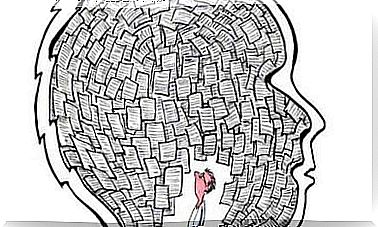Avoiding Personality Disorder: Social Isolation

Avoidant personality disorder affects 3% of the population. It describes sensitive, cautious people who have lived their lives inside lonely shells. They are afraid of being hurt, judged or rejected. They have an extreme desire to escape and cannot handle their fears and their anxiety for life. So they end up constructing the walls of their own fort where they want to hide.
This condition was defined in the early 20th century by the psychiatrists Bleuler and Kretschmer, but it is not very well known. In any case, not as much as, for example, obsessive-compulsive disorder or addictive personality disorder.
Historians and psychiatric experts provide an example: they say that the best example of a person with an avoidant personality disorder is Emily Dickinson.
Dr. Laurencie Miller explains this in her book “From Difficult to Disturbed”. The famous poet distanced herself from the world until she completely hid in her room. Many of her verses like “but grief-did not want me-so-now-good-night-day!” reflects this hermit.
They show her in the shadows of her own little world, where she was met by the discomfort she felt in relation to a society of which she did not feel a part. One where many of her relationships offered her more discomfort than happiness.
We know that a person can develop this avoidant tendency a little at a time, until it leads to a psychological breakdown that often requires the person to be admitted to a psychiatric clinic.
Psychiatrists define these people and this isolationist behavior as “shrinkers.” It may seem strange, but it seems that this trend is occurring less and less nowadays.

There was a time when people believed that an upbringing based on criticism, humiliation and contempt led to avoidant personality disorder. But when it comes to clinical disorders these days, we know that “2 plus 2 is never 4”. In other words, everyone reacts differently under the same circumstances.
And in the world of personality disorders, there are many governing factors in the environment. There are more related ailments and extremely dysfunctional thoughts.
DSM-V defines avoidant personality disorder as a form of social anxiety. In this case, self-esteem is so low that people begin to completely lose their social abilities. They reach a point where they prefer to be isolated, but the most complex thing about all of this is that their situations are totally egodystonic.
Their values, dreams, needs and identity are in a constant and unpleasant chaos. The mental exhaustion that follows as a result of this is enormous.
But people with an avoidant personality disorder are aware of what they should do to improve their situation, because they are generally very intelligent people. But the idea of responding to their fears, phobias and thoughts creates great anxiety. So they prefer to come up with excuses, postpone and leave the solution to the panic they feel today until tomorrow.

- They feel that no matter what they do, they will always be rejected and criticized.
- An excessive level of self-criticism. They see themselves as completely incompetent people in every context. It is common for them to say things to themselves such as “I am not made for this world” .
- They tend to exhibit an excessive level of dysphoria. In other words, they combine sadness with anxiety.
- They use an excessive “arsenal” of dysfunctional thoughts. “It’s better to do nothing than to try and then fail” “People are always critical. They love to humiliate everyone and they are indifferent to the needs of other people… ”
- In addition to social avoidance, there are also three others that they practice. They have a cognitive, behavioral and emotional avoidance. They do not want to think and deal with any emotions. That way, they will not have to confront what makes them afraid.
What causes these behaviors is the reinforcement of the cycle that keeps the anxiety alive. So to protect themselves from negative emotions, they choose to isolate themselves a little at a time.
A therapeutic relationship with someone who has an avoidant personality disorder often becomes long and does not give much. This is true for a variety of reasons.
The first is that they tend to believe that the psychologist will not understand their inner world. They believe that they will be repulsed by their thoughts, ideas and needs. Once the psychotherapist has gained their trust and builds a strong bond, we may see progress, but if this trust does not arise, we will probably not see any progress that strengthens the patient’s hope.
The things that a person with an avoidant personality disorder must work with are the following:
- Reformulate dysfunctional frameworks
- Work with their automatic thoughts and cognitive disorders
- Explore the origins of their avoidant behavior
- Think back to experiences that cause discomfort
- Strengthen social habits that can help him in daily life
- Make a progress chart and get better with their avoidant behavior
- Improve their social skills through group therapy
- Improve your self-esteem

As you can see, there are several strategies that a psychologist can use with these patients. We are dealing with a form of disorder where certain types of therapies can be helpful.
Cognitive behavioral, rational emotional and psychodynamic therapy as well as systematic desensitization are especially useful.









